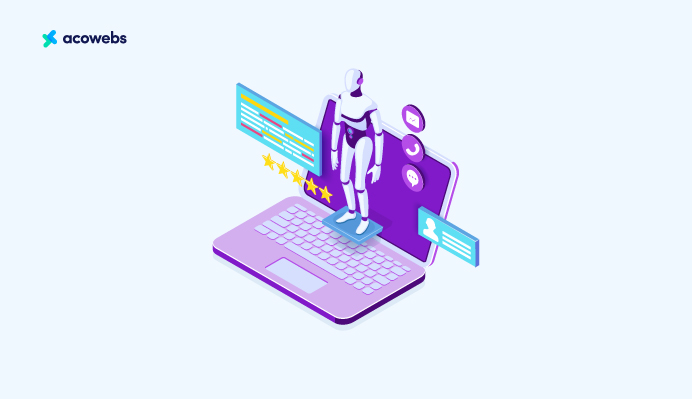Table of Contents
Success in the quick-paced world of eCommerce depends on being one step ahead of the competition and providing excellent client experiences. With the rise of cutting-edge technologies, one buzzword has captured the attention of online retailers across the globe: Generative AI.
This revolutionary technology was expected to grow exponentially from $10.28 billion in 2022 to $13.69 billion in 2023 at a staggering CAGR of 33.1%, transforming the digital commerce landscape.
Retailers may now provide personalized shopping experiences that adapt to individual interests by utilizing the power of AI-driven systems that can evaluate client data and behavior.
For eCommerce professionals, generative artificial intelligence is redefining the rules of the game by offering goods and services customized to each customer’s demands and improving supply chain management. All these efforts are improving eCommerce sales in general.
In this article, we explore the profound impact of this AI on the digital commerce ecosystem and delve into its top use cases across customer experience.
What Is Generative Artificial Intelligence (AI)?
Generative artificial intelligence (AI) is a subset of artificial intelligence that focuses on creating content rather than just analyzing or processing existing data. Unlike traditional AI based on rule-based systems or statistical pattern recognition, this AI utilizes deep learning techniques to generate new, original content.
Generative Artificial intelligence models, such as Generative Adversarial Networks (GANs) and Variational Autoencoders (VAEs), can produce new data samples similar to the training data they were exposed to.
These models learn the underlying patterns and structures of the data and then generate new instances based on that understanding.
For example, a generative Artificial Intelligence model trained on images of dogs can create new, previously unseen images of dogs that look realistic.

The two main types of this AI are:
- Text Generation: Text-based generative AI models create human-like text depending on a prompt or context. They are used in various applications, including chatbots, language translation, and creative writing.
- Image Generation: Image-based generative AI models create or modify new images. They are used in image synthesis, style transfer, and content creation for video games and animations.
Key Features of Generative Artificial Intelligence
Now that we have a brief understanding of Generative AI, let’s delve into its key features:
1. Content Generation
Generative artificial intelligence models produce brand-new data or content that closely reflects the patterns and traits seen in the training data. For instance, a language model can produce sentences and paragraphs that are grammatically correct and appear to have been authored by a human.
Like real photographs of items or scenes, an image generation model can create images that resemble those photographs.
2. Variability
Generative AI models are capable of providing a variety of distinct outcomes for a specific input or context. This unpredictable nature of the generation process is frequently managed by parameters or random sampling.
A generative text model, for example, might produce several different responses in response to the same input prompt, producing a variety of plausible responses.
3. Conditional Generation
Many generative of these models support conditional generation, meaning they can generate content based on certain conditions or input prompts.
For instance, a language model trained on movie scripts could generate dialogue for a specific character when provided with the character’s name as input.
4. Unsupervised Learning
This type of AI model often employs unsupervised learning techniques, which means they learn patterns and structures from data without explicit labels or human guidance. Instead, they extract meaningful information directly from the data, making them capable of learning from vast.
5. Applications
Generative Artificial Intelligence finds applications across various domains, such as natural language processing, computer vision, audio synthesis, and more.
Some examples of applications include language translation, image synthesis, voice generation, video generation, virtual reality content creation, and even generating personalized content in recommender systems.
How Generative AI Improves eCommerce Sales
If you’re an online retailer looking to stay ahead in the ever-evolving world of eCommerce, integrating generative Artificial Intelligence into your operations can offer significant benefits.
As the demand for personalized experiences grows, this AI presents numerous opportunities to cater to your shoppers’ unique preferences and interests.
Here are some use cases where generative AI can transform your online store:
1. Deliver Personalized Product Recommendations
Generative AI allows you to analyze vast amounts of data, including purchase history, browsing behavior, wish lists, and more, to tailor product recommendations for each shopper.
Knowing your consumers’ tastes can let you make highly relevant ideas that will appeal to them and increase sales.
Tools like Adobe Sensei and Salesforce Einstein are powerful personalization tools that can help you curate exceptional shopping experiences, increasing customer satisfaction and loyalty. This promotes an increase in eCommerce sales.
Below is an example of Adobe Sensei tool results in analyzing customer Journeys.

Understanding the customer journey provides valuable insights into the overall customer experience, helping businesses make informed decisions and improvements to their products, services, and marketing strategies.
2. Run Targeted Marketing Campaigns
Gone are the days of one-size-fits-all marketing. analytics and behavioral segmentation enable businesses to create targeted marketing campaigns.
Data analysis identifies customer preferences, allowing for personalized content and offers. Automated campaign management optimizes timing and delivery, while A/B testing refines strategies.
This AI predicts customer behavior and aids in customer retention efforts. Social media monitoring enhances engagement and sentiment analysis.
Compliance with data privacy regulations is paramount. These strategies ensure better ROI, increased sales, and improved customer satisfaction, reinforcing brand presence.
3. Consistent Product Descriptions for SEO Rankings
Generative Artificial Intelligence ensures consistent, brand-specific product descriptions that engage customers and optimize SEO rankings.
The AI creates educational, captivating material by being taught brand language and style rules, which enhances the buying experience.
SEO-optimized descriptions increase visibility, driving organic traffic and boosting customer confidence in the brand. This efficient process saves time and resources while establishing a strong brand identity and fostering loyalty.
With AI’s help, your businesses will deliver engaging, standardized product descriptions that resonate with customers and positively impact search engine rankings. This ultimately enhances the overall shopping experience and strengthens the brand’s online presence.
4. Optimized Product Images for Personalization
With generative AI, you can generate personalized product images based on textual input and historical image data.
This empowers you to showcase products in contexts that align with each shopper’s preferences, increasing their connection to the products and encouraging purchases.
Automating image generation saves time and resources while still delivering high-quality visual content that will increase your eCommerce sales.
5. Monitor and Optimize Product Prices
Generative Artificial Intelligence algorithms enable businesses to optimize product prices by tracking competitors, analyzing trends, and understanding demand patterns.
This data-driven strategy ensures competitiveness and profitability, capturing price-sensitive shoppers while preventing losses to rivals. Implementing AI models for real-time monitoring, segmentation, and personalization helps fine-tune pricing strategies.
Continuous iteration and compliance with ethical standards are crucial. Transparently communicating benefits to customers fosters loyalty.
6. Improve Inventory and Supply Chain Management
Generative AI optimizes inventory and supply chain management by forecasting demands, analyzing real-time data, and integrating sustainability metrics.
It enhances supplier management, risk assessment, and production planning. The AI-powered chatbots provide real-time order updates and improved customer support.
Continuous learning ensures adaptation to market changes, reducing costs and increasing efficiency.
7. Enhance Conversational AI for Customer Support
Enhancing Conversational AI for customer support involves advanced NLP and intent recognition, enabling chatbots to understand queries better.
Personalization using customer data and sentiment analysis creates more empathetic responses. Multilingual support expands the customer base, and seamless handoff to human agents handles complex issues.
Continuous learning and integration with knowledge bases ensure up-to-date and relevant responses. The result is efficient, personalized, and empathetic customer support, leading to higher satisfaction and improved shopping experiences.
Amazon utilizes chatbots with advanced NLP for instant and personalized responses, providing efficient and satisfying customer support around the clock.

8. Create Cross-Selling and Upselling Opportunities
Generative AI can analyze customer data to identify cross-selling and upselling opportunities based on previous purchase behavior.
With this knowledge, you can offer personalized product bundles or recommendations that complement each customer’s current choices.
You enhance the chance of generating more eCommerce sales by dynamically proposing extra items during checkout.
9. Generate Customized Transaction Flows
Generative AI enables you to create unique and customized shopping experiences for each customer. You create a highly personalized user journey by automatically populating product recommendations, offers, and content based on individual interests.
Updating and adapting these transaction flows based on AI insights ensures a seamless and engaging shopping experience.
10. Prevent Fraudulent and Phishing Activities
Protecting your online store from fraud and phishing is vital for customer trust. Use multi-factor authentication, SSL encryption, and regular security audits.
Implement AI-driven fraud detection systems and monitor user accounts for unusual activities. Educate customers about phishing and scams. Utilize anti-phishing tools, IP blocking, and partner with secure payment gateways.
Keep software updated, encrypt data, and provide employee training. Stay proactive in improving AI models with new data and collaborate with cybersecurity experts. A comprehensive strategy is essential to safeguard your platform and customer data from evolving threats.
Factors To Consider Before Selecting a Generative Artificial Intelligence Tool
Before selecting a generative artificial intelligence tool, it is essential to understand your objectives and use cases thoroughly. Below are factors to consider to achieve your AI tool goals.
1. Performance and Accuracy
Test the tool’s outputs and contrast them with content created by humans to assess the efficiency and precision of the generative AI. Look for tools with high accuracy rates and the ability to generate content that aligns with your brand’s tone and style.
2. Training and Fine-Tuning Capabilities
Consider whether the generative AI tool allows you to train and fine-tune the model using your own data. This feature can be valuable as it allows the AI to understand your domain better and deliver more relevant and personalized responses to customer queries.
3. Multi-Language Support
If your eCommerce business operates in multiple countries or serves customers who speak different languages, ensure that the AI tool supports multiple languages. This will enable you to provide consistent and effective customer service across different regions.
4. Performance Under Various Scenarios
Assess how the AI tool performs under different scenarios and use cases. For instance, does it handle complex customer inquiries, handle high volumes of queries efficiently, and adapt well to changing customer behavior?
5. Real-Time Support and Monitoring
Choose a tool that offers real-time support and monitoring capabilities. This ensures that any issues or errors can be addressed promptly, minimizing disruptions to your customer service operations.
6. Vendor Reputation and Reviews
Research the reputation of the AI tool’s vendor and read reviews from other users. Positive reviews and a strong track record indicate that the tool is reliable and effective.
7. Training and Support From the Vendor
Consider the level of training and ongoing support provided by the AI tool’s vendor. Adequate training is essential to maximize the tool’s capabilities, and reliable support can be crucial in resolving any technical or operational challenges.
8. Compliance With Industry Standards and Regulations
When ensuring compliance with industry standards and regulations for your AI-Generated tool, prioritize data privacy and AI ethics. How do you achieve this?
- Protect user information through data minimization and anonymization
- Mitigate bias and test for fairness to ensure unbiased outputs
- Emphasize transparency and explainability in decision-making
- Familiarize yourself with relevant regulations and seek legal advice as needed
- Obtain user consent, maintain a clear privacy policy, and provide user controls
- Regularly monitor and report on compliance, conducting audits when necessary
- Train yourself and your team on data privacy and AI ethics
- Verify third-party services’ compliance
- Stay updated to maintain an ethically sound and compliant AI tool
- Scalability of Pricing
As your business grows, the demand for AI-generated content may increase. Check whether the tool’s pricing scales proportionally with your usage, ensuring you can handle higher volumes without incurring excessive costs.
Examples of AI-Generated Tools
1. CopyMonkey

CopyMonkey is a platform designed to assist eCommerce businesses in creating optimized Amazon listings quickly and efficiently.
It utilizes AI-generated content to improve product listings’ performance on the Amazon marketplace. Businesses can potentially enhance their product descriptions, titles, bullet points, and other listing elements through this.
This optimization lead to increased visibility, higher search rankings, and ultimately more sales on Amazon.
2. Voiceflow

Voiceflow enables businesses to build conversational AI chat and voice assistants on a large scale. These chatbots and voice assistants can be integrated into eCommerce websites or applications to enhance the customer support experience and streamline the shopping process.
By utilizing AI-driven conversational interactions, businesses can improve customer engagement, provide personalized recommendations, answer queries, and address customer concerns effectively. This results in increased client happiness, client retention, and enhanced eCommerce sales.
3. Maverick

Maverick utilizes AI and Deep Tech to automate personalized video creation, allowing businesses to greet customers by name at scale. Benefits include increased engagement, conversions, retention, and revenue.
It enhances post-purchase thank yous, welcome series, win-backs, and abandoned cart recoveries, delighting customers. The platform saves time and resources while fostering genuine connections, promoting loyalty, and offering a scalable solution for businesses seeking efficient, personalized customer interactions.
4. Solidgrids

SolidGrids is an AI-powered tool for eCommerce businesses, transforming phone photos into marketable product images instantly. It enhances visuals, attracting potential customers and improving shopping experiences.
It conserves time and dollars by doing away with the necessity for pricey professional shots and editing. Businesses can maintain uniformity in their product catalogs by using automatic picture improvements. Ethical considerations regarding data privacy and biases are crucial in developing such AI tools.
5. Copysmith.ai

Copysmith.ai is an AI-driven tool that helps eCommerce businesses craft SEO-focused product descriptions quickly. It improves search rankings by automating content creation, which increases traffic to online stores.
The application streamlines the process in a few clicks by optimizing product descriptions for pertinent keywords using cutting-edge AI algorithms. It provides organizations with time-saving solutions, making it perfect for those who have large inventories or frequently updated product lines.
Conclusion
Selecting the right generative AI tool for your eCommerce customer service requires careful consideration of key factors. Budget, seamless integration, customization, and scalability should be prioritized to meet your evolving needs. Equally important is safeguarding data privacy and security to maintain customer trust.
Generative AI offers vast potential in the eCommerce industry, enabling personalized experiences, operational optimization, and improved customer satisfaction. Embracing AI in customer service, content generation, and predictive analytics can provide a competitive edge in the dynamic digital landscape.
However, it is crucial to implement AI responsibly and ethically. Transparency with customers about AI usage fosters trust and ensures data privacy compliance.
The effective adoption of generative AI in eCommerce empowers businesses to stay ahead in a fast-paced and competitive digital landscape.
By following these principles, you can make informed decisions and harness the full benefits of generative AI for your eCommerce business, driving growth and success in the ever-changing market.
Acowebs are the developers of the WooCommerce PDF Invoices and Packing Slips generate PDF invoices automatically and add them to the confirmation emails sent to your customers. We also have developed applications like Email Customizer and Designer For WooCommerce that helps you build and customize WooCommerce emails with a drag-and-drop user interface.











 Login
Login
 Cart
Cart








